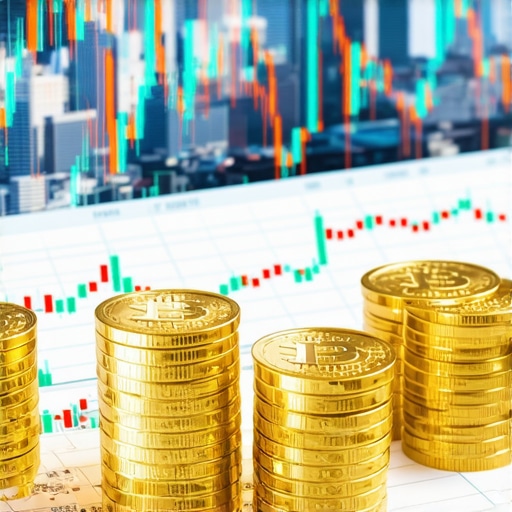Understanding the Current Gold Market Landscape
As we approach 2025, the gold market is poised for significant shifts influenced by various global factors. Investors and enthusiasts alike are keenly observing the dynamics that will shape gold’s value in the coming year. The gold market has always been a reliable indicator of economic stability and uncertainty, and understanding these trends is crucial for making informed investment decisions.
Key Trends Impacting Gold Prices in 2025
Several critical trends are emerging that will likely affect gold prices in 2025:
1. Global Economic Conditions
The economic environment plays a pivotal role in the gold market. With inflation rates fluctuating and central banks adjusting their monetary policies, gold often serves as a safe haven. In 2025, as global economies navigate post-pandemic recovery, the demand for gold as a hedge against inflation is expected to rise. Investors should keep an eye on global economic indicators, as they directly correlate with gold prices. For a deeper understanding of how these economic factors affect gold, read this article.
2. Central Bank Activities
Central banks around the world are significant players in the gold market. Their buying patterns can cause substantial fluctuations in gold prices. In recent years, many central banks have increased their gold reserves, signaling confidence in the metal as a long-term store of value. Analysts predict that this trend will continue in 2025, potentially driving prices higher. For insights on the influence of central bank purchases on gold prices, check out this post.
3. Technological Advancements in Gold Mining
As technology progresses, the gold mining sector is becoming more efficient. Innovations such as automation and advanced extraction techniques are lowering production costs, which can impact supply levels and, consequently, pricing. Understanding these technological developments will be key for investors looking to navigate the gold market in 2025. For an analysis of the best gold mining stocks, visit this guide.
4. Market Sentiment and Investor Behavior
Investor sentiment can be a powerful driver of gold prices. In times of uncertainty, investors tend to flock to gold, pushing prices up. Conversely, a bullish stock market might lead to reduced demand for gold. Keeping track of market sentiment and understanding how it impacts investor behavior will be essential for anyone looking to invest in gold in 2025. For strategies on managing gold investments, refer to this resource.
Conclusion: Preparing for the Future of Gold Investments
In conclusion, as we look ahead to 2025, the gold market is set to experience notable changes driven by economic conditions, central bank actions, technological advancements, and investor sentiment. By staying informed about these trends, investors can make strategic decisions that align with their financial goals. For a comprehensive overview of gold investment strategies, explore this article.
Impact of Global Events on Gold Prices
Global events play a crucial role in shaping the demand for gold. From geopolitical tensions to significant economic agreements, these occurrences can lead to fluctuations in gold prices. For instance, during times of political instability, investors often turn to gold as a safe investment. Understanding how international developments influence market trends is vital for any investor planning for 2025. For more insights into how global events affect gold prices, check out this article.
1. Inflation and Economic Recovery
Inflation concerns are on the rise, and as economies recover from the pandemic, the demand for gold as a hedge against inflation is becoming increasingly significant. Investors should monitor inflation rates and economic recovery indicators closely, as these factors will heavily influence gold prices. The relationship between inflation and gold is well-documented; when inflation rises, gold tends to follow suit. For a deeper dive into inflation’s impact on gold, read this post.
2. Supply Chain Disruptions
Supply chain disruptions, exacerbated by the pandemic, have led to increased production costs in the gold mining sector. As mining operations face challenges, the supply of gold may decrease, pushing prices upward. Investors should stay informed about the mining industry and potential disruptions that could affect gold availability. To learn about effective strategies for investing in gold mining stocks, visit this guide.
The Role of Technology in Gold Investments
Technological advancements are reshaping the gold market. Innovations in mining technology are streamlining production processes, thus impacting supply and pricing. Additionally, the rise of digital platforms for trading gold is making it easier for investors to buy and sell. Understanding these technological shifts can give investors an edge in navigating the gold market. For insights on the future of gold ETFs and how technology plays a role, explore this article.
1. Blockchain and Gold Trading
Blockchain technology is beginning to influence gold trading by ensuring transparency and security in transactions. This innovation allows for more accurate tracking of gold purchases, thus enhancing investor confidence. As technology continues to evolve, staying updated on these trends will be essential for investors looking to capitalize on the gold market. For a breakdown of how to approach gold ETFs for maximizing returns, refer to this resource.
2. Automation in Gold Mining
Automation is transforming the gold mining sector, reducing labor costs, and increasing efficiency. These developments can lead to lower production costs, which may influence gold prices positively. Investors should keep an eye on companies that are adopting these technologies, as they may yield better returns in the long run. For more information on effective gold trading techniques, check out this post.
Conclusion: Strategic Planning for Gold Investments
As we move towards 2025, understanding the myriad factors that influence gold prices—from global events and inflation to technological advancements—is crucial for making informed investment decisions. By staying informed and strategically planning, investors can navigate the complexities of the gold market effectively. For more comprehensive insights on how to evaluate gold prices, check out this guide.
Understanding Gold Demand Trends: Key Insights for Investors
The dynamics of gold demand are shifting, driven by various factors that influence its attractiveness as an investment. Investors should be aware of how these trends can affect their gold portfolio. Monitoring demand from central banks and emerging markets can provide vital clues about future price movements. For a comprehensive analysis of how demand affects gold prices, check out this article.
1. Central Banks and Gold Purchases
Central banks around the world are increasing their gold reserves, often as a strategy to diversify their assets and hedge against economic uncertainty. This trend highlights the enduring appeal of gold as a secure store of value, especially during turbulent economic times. Keeping track of central bank purchases can give investors valuable insights into future price developments. To learn more about the implications of central bank activity on gold prices, visit this post.
2. Emerging Markets and Gold Demand
Emerging markets, particularly in Asia, are witnessing a rising middle class that is increasingly investing in gold. This growing demand can have a significant impact on global gold prices. Understanding the purchasing habits of consumers in these markets can help investors anticipate price shifts. For an in-depth look at the factors driving demand in these regions, explore this guide.
Investment Vehicles: Exploring Options for Gold Investors
Investors can choose from a variety of vehicles to gain exposure to gold, each with its own set of benefits and risks. Understanding these options is crucial for making informed investment decisions. From physical gold to gold ETFs, each investment type offers different advantages depending on an investor’s goals and risk tolerance.
1. Physical Gold vs. Gold ETFs
Investing in physical gold—such as bullion bars and coins—offers a tangible asset that can be stored securely. However, it requires careful handling and storage considerations. On the other hand, gold ETFs provide a convenient way to invest in gold without the need for physical storage. They offer liquidity and ease of trading, making them an attractive option for many investors. For a detailed comparison of these investment types, check out this article.
2. Gold Mining Stocks and Mutual Funds
Investing in gold mining stocks or mutual funds can offer additional leverage to the price movements of gold. These investments can potentially yield higher returns than physical gold, but they also carry specific risks related to operational challenges and market volatility. It’s essential for investors to evaluate the performance of these stocks and funds closely. For insights into the best practices for investing in gold mining stocks, refer to this post.
Conclusion: Preparing for Gold Investment Opportunities in 2025
As the landscape of gold investments continues to evolve, understanding the intricate factors that drive demand and influence pricing is essential for successful investing. By keeping abreast of market trends and exploring various investment vehicles, investors can position themselves to make informed decisions as they navigate the complexities of the gold market. For more guidance on strategizing your gold investments, check out this guide.
Key Strategies for Maximizing Gold Investments
Investing in gold can be a lucrative venture if approached with the right strategies. By understanding market trends and employing effective investment techniques, investors can optimize their returns. Here, we explore several key strategies that can help maximize gold investment outcomes.
1. Diversifying Your Gold Investment Portfolio
Diversification is essential in any investment strategy, and gold is no exception. Investors should consider a mix of physical gold, gold ETFs, and gold mining stocks to spread risk across different asset types. This approach not only helps mitigate the impact of market volatility but also allows investors to capitalize on diverse opportunities. For more on diversifying your portfolio, check out this article.
2. Timing the Market: Understanding Gold Price Fluctuations
Gold prices are influenced by various factors, including economic indicators, geopolitical events, and changes in demand. Understanding how to time your investments based on these fluctuations can enhance your profitability. Keeping abreast of news and conducting regular market analysis can provide insights into potential price movements. For an in-depth guide on tracking gold price trends, visit this guide.
Investment Vehicles: Choosing the Right Option for You
As discussed previously, the choice of investment vehicle can significantly impact your investment strategy. Each option, whether it’s physical gold, gold ETFs, or mining stocks, comes with its own set of advantages and disadvantages. It’s crucial to evaluate which vehicle aligns best with your investment goals and risk tolerance.
1. Evaluating Gold Mining Stocks
Investing in gold mining stocks can be particularly rewarding, especially during bullish market conditions. These stocks often outperform physical gold when prices rise. However, they can also be subject to operational risks and market fluctuations. Understanding the fundamentals of the mining companies, including their production capacities and financial health, is key. For more insights on investing in mining stocks, review this post.
2. Understanding Gold ETFs: Key Features and Benefits
Gold ETFs are increasingly popular due to their liquidity and ease of trading. They provide investors with exposure to gold prices without the need for physical storage. Understanding the different types of gold ETFs available in the market, including those that focus on physical gold versus those that invest in gold mining companies, can help you make informed decisions. For a beginner’s guide to gold ETFs, check out this resource.
Conclusion: Preparing for Future Gold Investment Opportunities
As the gold market continues to evolve, staying informed about trends and changes is crucial. By employing effective investment strategies, diversifying your portfolio, and understanding the intricacies of various investment vehicles, you can position yourself for success in the world of gold investments. For further reading on gold investment strategies, explore this article.
Comprehensive FAQ Section
1. What are the best ways to invest in gold?
The best ways to invest in gold include purchasing physical gold, investing in gold ETFs, and buying gold mining stocks. Each method has its own advantages, so it’s essential to consider your investment goals and risk tolerance.
2. How does gold act as a hedge against inflation?
Gold is often viewed as a hedge against inflation because its value tends to rise when the purchasing power of fiat currencies declines. As inflation increases, more investors turn to gold to preserve their wealth, which can drive prices higher.
3. What factors influence gold prices?
Gold prices are influenced by various factors, including economic indicators (like interest rates and inflation), geopolitical tensions, supply and demand dynamics, and market sentiment. Understanding these factors can help investors make informed decisions.
4. Is it better to invest in physical gold or gold stocks?
Investing in physical gold provides tangible assets that can protect against economic downturns, while gold stocks can offer leveraged exposure to gold price movements. The choice depends on your investment strategy and risk appetite.
5. How can I track gold price trends effectively?
To track gold price trends effectively, consider using financial news platforms, price tracking apps, and market analysis reports. Regularly monitoring these resources can help you identify patterns and make timely investment decisions.
6. What are gold ETFs and how do they work?
Gold ETFs are funds that invest in gold and trade on stock exchanges. They provide investors with exposure to gold prices without the need for physical ownership. Gold ETFs can be a cost-effective and liquid way to invest in gold.
7. What should I know before investing in gold mining stocks?
Before investing in gold mining stocks, it’s vital to understand the company’s financial health, production capabilities, and market position. Additionally, consider the operational risks associated with mining activities that can impact stock performance.
8. Can I invest in gold through retirement accounts?
Yes, you can invest in gold through retirement accounts such as IRAs. Certain types of gold, including bullion and coins meeting specific standards, can be held in a self-directed IRA.
9. How do geopolitical events affect gold prices?
Geopolitical events such as wars, political instability, and economic sanctions can lead to increased demand for gold as a safe-haven asset. This heightened demand can drive prices up, making gold an attractive option during uncertain times.
10. What are the risks involved in gold investment?
Risks involved in gold investment include price volatility, market fluctuations, regulatory changes, and, for physical gold, issues related to storage and security. It’s crucial to evaluate these risks before committing your capital.
Authority Resources for Gold Investment
For those looking to deepen their understanding of gold investments, here are some trusted resources:
- World Gold Council – Offers comprehensive insights on gold market trends, statistics, and investment strategies.
- Investopedia – Provides articles, tutorials, and guides on gold investment and financial education.
- Kitco – A reliable source for live gold prices, market analysis, and expert opinions.
- CNBC Gold News – Covers the latest news and updates on gold prices and market movements.
- Fidelity Investment Guides – Offers resources and articles on how to invest in gold and the benefits of gold investments.
Conclusion: Embracing Gold Investments for Financial Growth
In conclusion, maximizing your gold investments involves a combination of strategic planning, market understanding, and informed decision-making. By diversifying your portfolio, selecting the right investment vehicles, and staying informed through reputable resources, you can navigate the complexities of the gold market effectively. As you embrace these strategies, remember that gold investment not only serves as a potential source of wealth but also as a safeguard against economic uncertainties. For further insights on gold investment, continue exploring resources that enhance your knowledge and confidence in this precious metal.










